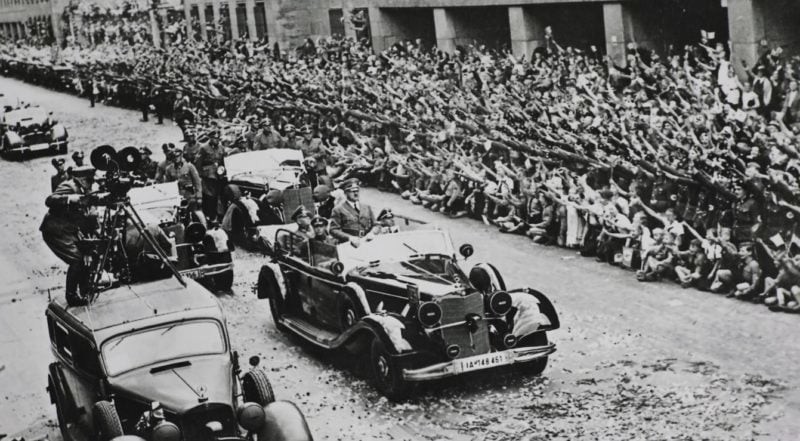Bad guys, throughout history, often have a penchant for impressive cars. From Josef Stalin’s ZIS-115 to Benito Mussolini’s Lancia Astura, and the Mercedes 600 Grosser favored by numerous despots, powerful figures with questionable morals have long been associated with remarkable automobiles. Among these infamous vehicles, one stands out due to its direct link to arguably the most reviled figure in modern history: Adolf Hitler. This week, we delve into the story of one of Hitler’s Mercedes, a Mercedes-Benz 770K Grosser Offener Tourenwagen, a car not just historically significant, but also a captured war trophy from the Allied forces.
This particular Mercedes-Benz 770K, a vehicle with chassis number 189744, wasn’t just any car; it was commissioned by Erich Kempka, Hitler’s personal chauffeur. Upon completion, the factory itself designated it the “fourth Führer-Car”. While Hitler maintained a fleet of these imposing Mercedes vehicles, each served different purposes. This specific model was primarily reserved for state visits, intended to transport not only the Nazi dictator but also visiting heads of state and other prominent figures of that dark era. It became more than just Hitler’s Mercedes; it was a symbol of power and a conveyance for some of history’s most notorious individuals.
For a car tasked with carrying such significant – albeit sinister – figures during the 1930s and 40s, security was paramount. This Hitler’s Mercedes was equipped with the highest-end protection available at the time. Thick bulletproof windows and reinforced panels were designed to withstand 30mm shells. Furthermore, pop-up armor plates offered additional protection depending on the perceived threat level. While the convertible design might seem at odds with such heavy security, the open-top style served another purpose: allowing the dictator to be seen, to wave to crowds, a crucial element in projecting an image of power and popularity.
The exact deployment history of this Hitler’s Mercedes during World War II remains largely undocumented. However, existing records confirm its presence at three pivotal historical events. The first was on June 18, 1940, during a parade in Munich, where Hitler and Mussolini rode together in this very Grosser Offener Tourenwagen. Following the fall of France, on July 6, 1940, another victory parade was held, with Hitler again choosing chassis 189744 to mark the occasion. Its final documented appearance occurred on May 4, 1941, after the Nazi conquests of Yugoslavia and Greece, in yet another victory parade where this specific 770K served as the Führer’s vehicle of choice.
As the tide of World War II turned in 1943, and Allied forces intensified their attacks on Germany, the era of victory parades came to an end. The Mercedes-Benz 770K production line itself suffered a significant blow during heavy bombing raids on Sindelfingen, the location of its factory, effectively halting its manufacture. By 1945, with the liberation of Nazi Germany underway, the US Army seized numerous vehicles belonging to Hitler’s regime, including this 770K. Recognizing its historical importance, rather than destroying it, the Army claimed it as a war trophy and relocated it to France.
In France, this Hitler’s Mercedes became part of a motor pool for US officers. Driving a vehicle once used by such a figure must have been a surreal experience for the soldiers, a stark symbol of victory over tyranny. After its military service, the car began a journey through various owners across Europe and the United States. One particularly unusual transaction involved A.H. Vander Elst, Jr., a Belgian tobacco magnate. In post-war Europe, tobacco was a valuable commodity, and Vander Elst traded the car for $1,800 worth of tobacco to Tom N. Austin, another prominent figure in the tobacco industry.
Austin, in turn, donated the vehicle to his local Veterans of Foreign Wars branch as a war relic. However, the VFW lacked the resources to maintain such a complex machine, and Hitler’s Mercedes was soon relegated to storage in a shed, falling into disrepair.
In 1976, classic car collectors Steve Munson and Joe Ogden rediscovered the 770K. Initially believing it to be associated with SS Commander Heinrich Himmler, they soon uncovered its true, even more significant, history as one of Hitler’s Mercedes. Recognizing its historical importance, they undertook a full restoration to bring it back to its original factory condition. Following its restoration, the car became a traveling exhibit, appearing in numerous museums. Casino magnate Ralph Engelstad acquired it in 1983, adding it to his Imperial Palace Auto Collection in Las Vegas, Nevada.
After Engelstad’s death in 2002, his collection was sold, and this remarkable piece of history returned to Europe, becoming part of a 21-car private collection. Now, nearly eight decades after its construction, this Hitler’s Mercedes was once again offered for auction by Worldwide Auctioneers in Scottsdale, Arizona. While no pre-auction estimate was publicly available, previous appraisals valued it at over a million dollars.
Despite its dark past and association with a figure of immense evil, many argue that this Hitler’s Mercedes should be preserved. It represents a chillingly important artifact of both automotive and world history. Adding a positive dimension to its story, 10% of the auction proceeds were pledged to be donated to organizations dedicated to Holocaust education, ensuring that the lessons of history are not forgotten and that future generations understand the factors that led to such atrocities. This car, therefore, is not just a machine, but a stark reminder of history and a vehicle for education and remembrance.
